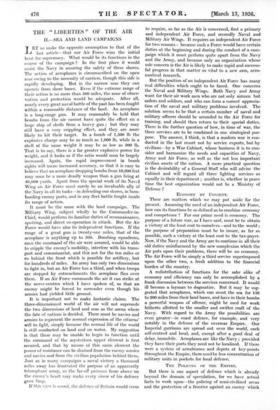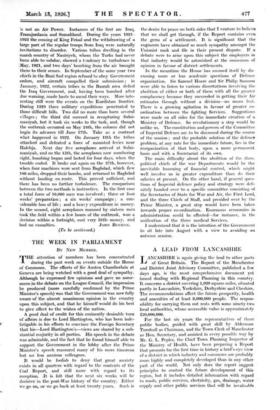THE " LIBERTIES " OF THE AIR II.—SEA AND LAND
CAMPAIGNS T ET us make the opposite assumption to that of the a last article—that our Air Force wins the initial bout for supremacy. What would be its functions in the course of the campaign ? In the first place it would assist the Navy in assuring the safety of these shores. The action of aeroplanes is circumscribed on the open seas owing to the necessity of carriers, though this side is rapidly developing. But in the narrow seas they can operate from shore bases. Even if the extreme range of their action is no more than 500 miles, the zone of obser- vation and protection would be adequate. After all, nearly every great naval battle of the past has been fought within a reasonable distance of the land. An aeroplane is a long-range gun. It may reasonably be held that bombs from the air cannot have quite the effect on a large ship of shells from a heavy gun ; but they may still have a very crippling effect, and they are more likely to hit their target. In a bomb of 1,500 lb the explosive charge may be as much as 1,000 lb, while in a shell of the same weight it may be as low as 300 lb. That is to say, there is a far greater explosive power for weight, and it looks as if the ratio would soon be largely increased. Again, the rapid improvement in bomb sights will mean increased accuracy, so that it is easy to believe that an aeroplane dropping bombs from 10,000 feet may soon be a more deadly weapon than a gun firing at 40,000 yards. Apart from the special work of its Nava Wing an Air Force must surely be an invaluable ally of the Navy in all its tasks—in defending our shores, in bom- barding enemy ports, and in any fleet battle fought inside its range of action.
It must be the same with the land campaign. The Military Wing, subject wholly to the Commander-in- Chief, would perform its familiar duties of reconnaissance, spotting, and direct co-operation in attack. But the Air Force would have also its independent functions. If the range of a great gun is twenty-one miles, that of the aeroplane is anything up to 500. Bombing squadrons, once the command of the air were assured, would be able to cripple the enemy's mobility, interfere with his trans- port and commissariat, and this not for the ten miles or so behind the front which is possible for artillery, but for hundreds of miles. An army has only two dimensions to fight in, but an Air Force has a third, and when troops are stopped by entrenchments the aeroplane flies over them. If an Air Force commands the air it can strike at the nerve-centres which I have spoken of, so that an enemy might be forced to surrender even though his armies had yielded little ground.
It is important not to make fantastic claims. The three-dimensioned world of the air will not supersede the two dimensions of land and seas as the arena where the fate of nations is decided. There must be navies and armies to represent the normal expression of the citizens' will to fight, simply because the normal life of the world is still conducted on land and on water. My suggestion is that these may be unable to begin to function until the command of the mysterious upper element is first secured, and that by means of this same element the power of resistance can be drained from the enemy armies and navies and from the civilian population behind them. Just as in many campaigns a naval victory a thousand miles away has frustrated the purpose of an apparently triumphant army, so the far-off pressure from above ou the enemy's heart may make every sinew of his defence grow limp.
If this view is sound, the defence of Britain would seem to require, so far as the Air is concerned, first a primary and independent Air Force, and secondly Naval and Military Air Wings. It requires an independent Air Force for two reasons : because such a Force would have certain duties at the beginning and during the conduct of a clam- paign which it must perform quite apart from the Navy and the Army, and because only an organization whose sole concern is the Air is likely to make rapid and success- ful progress in that matter so vital to a new arm, aero- nautical research.
But the position of an independent Air Force has many real difficulties which ought to be faced. One concerns the Naval and Military Wings. Both Navy and Army want for their air work men who are not only airmen but sailors and soldiers, and who can form a correct apprecia- tion of the naval and military problems involved. The solution seems to be that a certain number of naval and military officers should be seconded to the Air Force for training, and should then return to their special duties. There is the further question of how, in time of war, the three services are to be combined in one strategical pur- pose. The answer, I think, is that a modern war is con- ducted in the last resort not by service experts, but by civilians—by a War Cabinet, whose business it is to con- sider and harmonize the needs and capacities of Navy, Army and Air Force, as well as the not less important civilian assets of the nation. A more practical question is the desirability of a General Staff who will advise the Cabinet and will regard all three fighting services as equally in their department ; another is, whether in peace time the best organization would not be a Ministry of Defence ?
ECONOMY BY CONSENT.
These are matters which we may put aside for -the present. Assuming the need of an independent Air Force, how can its functions be so defined as to combine economy and competence ? For our prime need -is economy. The purpose of a future war, as I have said, must be to obtain a victory at the least cost to ourselves—and to 'the world ; the purpose of preparation must be to insure, as far as possible, such a victory at the least cost to the tax-payer. Now, if the Navy and the Army are to continue in all their old duties uninfluenced by the new complexion which the Air puts upon their problems, there will be no economy. The Air Force will be simply a third service superimposed- upon the other two, a fresh addition to the financial burden of the country.
A redistribution of functions for the sake alike of economy and efficiency can only be accomplished by a frank discussion between the services concerned. It would ill become a layman to dogmatize. But it may be sug- gested that aeroplanes, which can scout the sea for 150 to 200 miles from their land bases, and have in their bombs a powerful weapon of offence, might be used for work hitherto allotted to the smaller and swifter craft of the Navy. With regard to the Army the possibilities are even greater—in coast defence, for example, and very notably in the defence of the overseas Empire., Our Imperial garrisons are spread out over the world, each self-centred and local, and, except after a good deal of delay, immobile. Aeroplanes are like the Navy ; provided they have their ports they need not be localized. If there were a system of aerodromes and depots at key-points throughout the Empire, there need be less concentration of military units in pockets for local defence.
THE POLICING OF THE EMPIRE.
But there is one aspect of defence which is already beyond the domain of speculation, for we have actual facts to work upon—the policing of semi-civilized areas and the protection of a frontier against an enemy which is not an Air Power. Instances of the first are Iraq, .Transjordania and Somaliland. During the years 1921- 1922 the coming of Xing Feisal and the withdrawing of a large part of the regular troops from Iraq were naturally invitations to disorder. Various tribes dwelling in the marsh country of Nasiriyeh, whom the Turks had never been able to subdue, showed a tendency to turbulence in May, 1921, and two days' bombing from the air brought `them to their senses. In September of the same year two .chiefs in the Bath Sad region refused to obey -Government orders, and aircraft compelled their submission ; in January, 1922, certain tribes in the Basrah area -defied the Iraq Government, and, having been bombed after due warning, made haste to mend their ways. More inte- resting still were the events on the Kurdistan frontier. During 1919 three military -expeditions penetrated to those -difficult hills. Two did no more than burn several villages ; the third did succeed in recapturing Sulai- maniyah, but it took six weeks to the task, and, though the outbreak occurred on May 24th, the column did not begin -its advance till June 17th. Take as a contrast what happened in 1922. On January 18th the tribes' attacked and defeated a force of mounted levies near Halebja. Next day five- Aeroplanes -arrived at Sulai- rnaniyah, and on the 15th, the aeroplanes now numbering eight, :bombing began and lasted for four days, when the trouble ended. It broke out again on the 27th, -however, when four machines were sent from Baghdad; which flew 180-miles, dropped their bombs, and returned to Baghdad without- landing -en route. This proved sufficient, and there has been no further turbulence. The comparison between the two methods -is instructive. In the first ease a total force of 10,000 men was involved ; three or four weeks' preparation ; a six weeks' campaign.; a con- siderable loss-of life ; and a heavy expenditure in money. In the -second, eight -aeroplanes manned by sixteen men took-the field within a few: ours of the outbreak, won a decision within a fortnight; cost -very little money, and .(To be continued.)































































 Previous page
Previous page